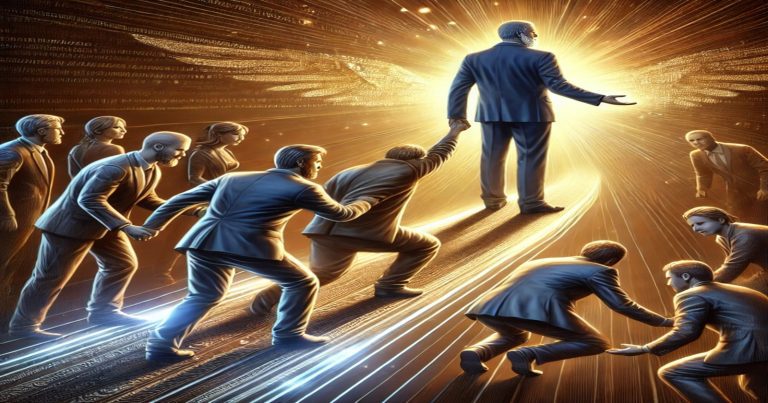As a concept, leadership speaks to an individual or group influencing and inspiring other individuals or groups to accomplish common goals and objectives. Leadership is beyond dispensing or exerting power; it is about inspiring, directing, and often attempting to support third parties in attaining a goal, sometimes defined by the organisation’s mission and values. The concept of management leadership and its application to a management environment determines the effectiveness of the teams, the quality of the decisions made, and the eventual attainment of the organisational goals. Leaders become responsible for determining the vision, setting strategies, and orienting their teams towards success under a mutual respect and cooperation culture.
Define Leadership
The definition of leadership is complex and dynamic, bringing in varied roles, responsibilities, and styles, and it is equally important in all sectors, namely business, education, healthcare, and politics. Leadership ensures that objectives are realised and that people or teams are motivated to achieve a common goal. Changing leadership theories have emerged throughout history, aiming to explain and guide how different leadership styles could be exercised in various contexts. This paper will analyse leadership theories, styles, and other essential variables that may be part of successful leadership in modern organisations.
What is a Leader?
A leader guides the organisation’s directions, guidance, and support. Leaders influence and inspire followers to achieve common goals by setting objectives, motivating them, and fostering teamwork. The role of a leader also involves issuing orders; leaders have to make crucial decisions whereby they guide their team members in overcoming barriers toward achieving a culture of trust and respect.
Leaders usually display qualities that distinguish them from others, such as vision, resiliency, empathy, communication skills, and emotional intelligence. These qualities enable them to rally their teams toward a common goal. A leader should be a decision-maker flexible enough to read the time and context correctly and adjust accordingly in a dynamic or uncertain environment.
Role of a Leader
A leader meets many roles in an organisation.
- Decision Maker: By definition, a leader makes decisions that are fundamental to directing the organisation. This involves making decisions about strategies, goals, and resource allocations.
- Motivator: Leaders motivate and encourage teams to achieve common goals. They instil a sense of ownership and commitment in the team.
- Coaches and Mentors: Leaders guide team members in their career development. They mentor team members and give constructive feedback to help individuals grow in their careers.
- Problem Solver: A leader is regularly confronted with conflict, and problems-problem-solving is an essential trait for a leader.
These, in turn, allow the leader to affect the organisational culture, productivity, and success greatly.
Leadership Styles
Leadership styles refer to the various avenues leaders adopt to influence and motivate their teams. Understanding the various leadership styles matters greatly, as all leaders significantly affect the organisational culture, employee satisfaction, and performance. Each approach may be appropriate for a different situation or with other individuals. The leadership styles are:-
Autocratic Leader
A leader who opts for autocratic leadership styles and decides on behalf of subordinates. This is why these types of leaders are sometimes considered dictatorships. The leader has full control and expects subordinates to follow orders. While effective for quick decision-making, this type brings dissatisfaction and low morale if overindulged.
Democratic Leader
This style involves considering the team members’ opinions before any decisions can be passed to the leader. Leaders, in this case, are believers in consultancy and mutual decisions or discussions. Therefore, a democratic leader can lead to the team’s great motivation and creativity, but the downside is that decisions can be delayed.
Transformational Leader
As its name reflects, transformational leaders inspire and motivate the team depending on the vision, which paves the way for innovations. The focus is on personal growth and development and keeps employees extra motivated. Leadership is particularly effective for organisations that need change processes.
Laissez-faire Leader
This style of leadership is followed with a laid-back approach. The leader lets team members react to their own decisions. The style works when the team is skilled and motivated but can lead to disorder and lack of direction in exceptional instances.
Servant Leader
At the same time, they put forth their members’ needs before their own. They are inclined to support and help others develop their success. This style of trust engenders close linkages. It might not be effective in agencies where a leader is anticipated to have power.
Transactional Leader
Transactions between the leader and the followers become a matter of concern in this leadership style. As required, rewards, punishments, or both are utilised by the leader. Results-oriented, it can deliver results in a highly competitive environment.
Characteristics of Leadership
Great leaders are distinguished by unique qualities that enable them to lead and motivate others. These attributes develop over time and can be enhanced with self-reflection, education, and experience. The successful understanding of these characteristics can serve as a guide for anyone seeking leadership improvement.
- Creative Thinking: An essential trait in a leader; they must see what lies ahead, set long-term goals, and draw upon the path to success. Creative thinking involves inspiration for the team or the organisation.
- Emotional Intelligence (EQ): A person has the so-called EQ when he is self-aware of his emotions or knows how people around him feel. A good EQ leader does well at conflict resolution, bonding, and fostering trust in the team.
- Decisiveness: Strong leaders make quick, assertive decisions with clarity, even amidst uncertainty. Decisiveness induces followers’ confidence, leading to action by all concerned.
- Honesty: A good leader acts fairly and honestly in everything they do. The confidence built by their honesty will lead the team in the right direction concerning long-term success.
- Adaptability: Leadership means being able to change what needs to change. Those who are adaptable can quickly adapt to emerging uncertainty and positively influence the development of their organisation.
- Empathy: A great leader guards his ability to understand the needs, concerns, and emotions of the people he supervises. It creates an atmosphere where work becomes a pleasure and builds a bond between leaders and followers.
- Leadership Communication Skills: Communication skills are fundamental to leadership. Leaders must effectively present and share their ideas, listen tediously, and engage in feedback that assists their workers in advancing the cause.
Theories of Leadership
Leadership theories provide frameworks for explaining how leadership works in organisations and how leadership can be ameliorated by inspiring motivation in teams. Accumulated over time are various theories explaining the different styles and traits of leadership in existence. Key leadership theories are:-
Trait Theory
According to the trait theory, effective leaders have specific traits or characteristics such as intelligence, confidence, integrity, etc. Trait theory mainly identifies the personal attributes that distinguish leaders from non-leaders.
Behavioural Theories
The behavioural approach to leadership states that leadership is a function of the actions one can see and observe, which means it is behaviour-based. Leaders can be made with learned behaviours like communication, decision-making, and problem-solving skills.
Contingency Theories
Contingency theory often contradicts itself by stating that each situation is different; therefore, no best leadership style exists. Effectiveness varies with the problem, including tasks, team needs, and the environment. Thus, the leader must adapt to these situations.
Transformational Leadership Theory
Transformational Leadership Theory was developed by Bernard Bass and James Burns, who observed that transformational leaders inspire and encourage followers with a compelling vision, promote creativity, and offer opportunities for personal growth. These leaders had long-term change and innovation as an agenda.
Transactional Leadership Theory
Transactional leadership theory is based on rewards and punishments to motivate followers. It is effective in situations where structure and tasks are clearly outlined but may not inspire or motivate for long-term development.
Leader-Member Exchange (LMX) Theory
This relationship-oriented leadership theory includes studies on leader-follower relationships in groups. Leaders develop strong and often dyadic relationships with individual team members, and these relationships may impact the effectiveness of leadership.
Importance of Leadership
Leadership is important as it is the source of any organisation’s success or failure. It directs the strategy that guides an organization in the right direction, along with the employees’ culture, morale, and productivity. When done well, leadership creates a good work environment and encourages innovation and employee engagement. Leadership is also important for managing change, dealing with crises, and efficiently fulfilling organizational objectives.
- Setting Direction and Vision: Leaders clarify and pave the way for the organization. An effective leader formulates a vision that is, in essence, a common thread that binds the whole team in spirit, aligning with long-term goals.
- Building Relationships and Maintaining Them: Leadership is built on relationships. Leaders create trust and respect among the team members, cultivating an environment where employees feel very important and leading them to loyalty and productivity.
- Fostering Innovation: A good leader encourages the team to be inventive and innovative. He creates an environment where new ideas are welcomed to keep pace with perpetual improvement and progress.
- Managing Changes: Too rapid changes from an organization need to change them according to the changing environment. A Leader qualifies it by setting the swerve guidance to impose a shift under the facilitation of transition to find a competitive edge soon.
- Initiating Employee Morale: A good leader can keep his subordinates happy. The morale improves when a leader recognizes achievements and stands by employees, thus facilitating optimum performance.
Concept of Leadership FAQs
What is leadership?
Leadership is influencing, directing, and inspiring a person or group toward achieving common goals. Effective leadership is setting a direction and taking decisions in a joint environment that leads to the outcomes of success.
What are the types of leadership?
Types of leadership include autocratic leadership, democratic leadership, transformational leadership, laissez-faire leadership, servant leadership, and transactional leadership. Depending on the needs of each organization, a leader can combine the types according to them.
What is transformational leadership theory?
Transformational leadership theory states that such a leader motivates and inspires followers to achieve organizational objectives by formulating a fascinating vision, nurturing innovations, and concentrating on change over longer periods. Such leaders stimulate the creative mindset of their team members and provide a place for self-growth.
Why is leadership important within a business?
Business leadership sets the direction, manages change, encourages innovations, and sustains the morale of business members. The operations of leaders enable organizations to successfully pursue their goals of achieving an objective and adapting and inspiring others toward accomplishing the same outcome.
How do leadership theories aid in management?
Leadership theories should provide concepts that help leaders understand how different leadership styles impact organisational success. Thus, these theories will help leaders formulate workable strategies in team management, decision-making, and developing a good corporate culture.


